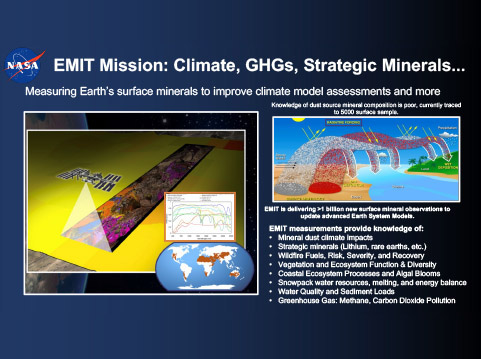Seminars
The EMIT Science Mission and Three Decades of Imaging Spectroscopy Observations for Earth System Science and Applications
October 31, 2023
| 180-101 conference room (in person) & WebEx, 1:00 pm PT

About this Lecture

NASA’s Earth Surface Mineral Dust Source Investigation (EMIT) imaging spectroscopy instrument was launched to the International Space Station (ISS) on July 14, 2022. The EMIT science team is using these new comprehensive observations of surface mineralogy across the Earth’s arid land dust source regions to update the initialization conditions of Earth System Models to understand and reduce uncertainties in mineral dust radiative forcing at the regional and global scale now and in the future. EMIT’s science objectives bring together observations and models of the Earth’s surface, atmosphere, and energy balance elements as well as support science and applications spanning terrestrial ecosystems, aquatic ecosystems, geology, cryosphere, and other components and processes across the Earth System.
The success of EMIT is traced to three decades of NASA leadership in Earth System imaging spectroscopy observations. The first imaging spectrometer, AIS, was flown in 1982 for geologic science and applications and delivered unexpected discoveries on its first flights. A series of imaging spectrometers and observations have contributed to science and applications advances throughout the Earth System, including most recently a capability to detect methane and carbon dioxide point source emissions. Looking forward, these imaging spectroscopy observations of our Earth promise to enable new science, understanding, and Earth action opportunities across the Earth system in this time of rapid change.
About

Robert O. Greenis the principal investigator of the Earth Surface Mineral Dust Source Investigation (EMIT), a state-of-the-art imaging spectroscopy instrument on the International Space Station. Green is the principal investigator for AVIRIS, with more than 35,000 Google Scholar results. He was the instrument scientist for the NASA Moon Mineralogy Mapper (M3) that discovered water/hydroxyl on the illuminated surface of the Moon. He is a science co-investigator and Instrument Scientist on the Mapping Imaging Spectrometer for Europa (MISE) and a science co-investigator on the NASA Lunar Trailblazer mission to investigate the occurrence of volatile compounds and minerals on the Moon. At JPL, he is the instrument scientist for the Carbon Plume Mapper imaging spectrometer to measure and mitigate sources of methane. Green is a senior research scientist, JPL Fellow, and director of the Microdevices Laboratory. For more than 25 years, his research has used remote measurement via imaging spectroscopy to test hypotheses and pursue scientific investigations and applications on Earth and for discovery through the solar system.
